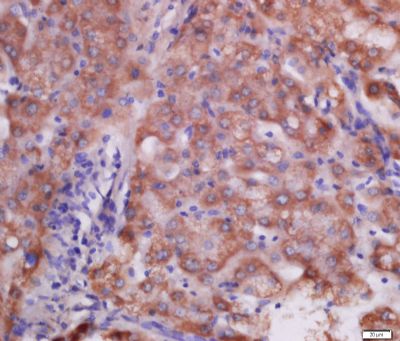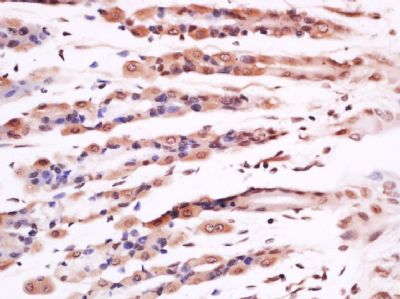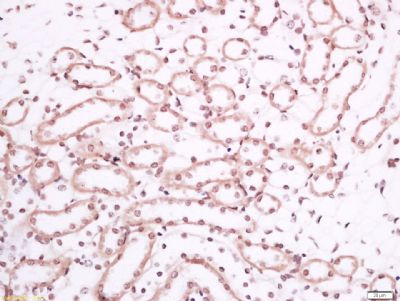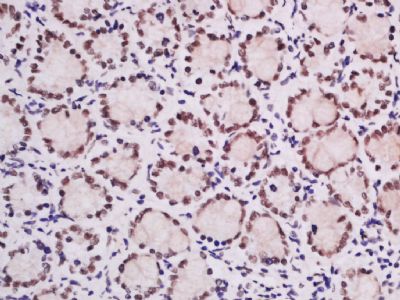Ubiquitously expressed transcript Polyclonal Antibody
Purified Rabbit Polyclonal Antibody (Pab)
- 产品详情
- 实验流程
Application
| IHC-P, IHC-F, IF, E |
|---|---|
| Primary Accession | Q9UBK9 |
| Reactivity | Rat, Pig, Dog, Bovine |
| Host | Rabbit |
| Clonality | Polyclonal |
| Calculated MW | 18246 Da |
| Physical State | Liquid |
| Immunogen | KLH conjugated synthetic peptide derived from human UXT/Ubiquitously expressed transcript |
| Epitope Specificity | 85-157/157 |
| Isotype | IgG |
| Purity | affinity purified by Protein A |
| Buffer | 0.01M TBS (pH7.4) with 1% BSA, 0.02% Proclin300 and 50% Glycerol. |
| SIMILARITY | Belongs to the UXT family. |
| SUBUNIT | Homohexamer. Interacts with LRPPRC. Interacts with AR N-terminus. In the nucleus interacts specifically with RELA and forms a dynamic complex with NF-kappa-B and is recruited to the NF-kappa-B enhanceosome upon stimulation. Interacts with MECOM and URI1. |
| Important Note | This product as supplied is intended for research use only, not for use in human, therapeutic or diagnostic applications. |
| Background Descriptions | UXT is a novel protein, highly conserved in mouse. It interacts with the N terminus of the androgen receptor and plays a role in facilitating receptor-induced transcriptional activation. It is abundantly expressed in tumor tissues and is likely to be involved in tumorigenesis. |
| Gene ID | 8409 |
|---|---|
| Other Names | Protein UXT, Androgen receptor trapped clone 27 protein, ART-27, Ubiquitously expressed transcript protein, UXT |
| Target/Specificity | Ubiquitous. Expressed in prostate epithelial cells. Overexpressed in a number of tumor tissues (PubMed:16221885). Highest levels in the heart, skeletal muscle, pancreas, kidney, liver, adrenal gland, peripheral blood leukocytes, lymph node, prostate, and thyroid and the lowest levels in bladder and uterus. |
| Dilution | IHC-P=1:100-500,IHC-F=1:100-500,IF=1:100-500,ELISA=1:5000-10000 |
| Format | 0.01M TBS(pH7.4) with 1% BSA, 0.09% (W/V) sodium azide and 50% Glyce |
| Storage | Store at -20 °C for one year. Avoid repeated freeze/thaw cycles. When reconstituted in sterile pH 7.4 0.01M PBS or diluent of antibody the antibody is stable for at least two weeks at 2-4 °C. |
| Name | UXT |
|---|---|
| Function | Involved in gene transcription regulation (PubMed:21730289, PubMed:28106301). Acts in concert with the corepressor URI1 to regulate androgen receptor AR-mediated transcription (PubMed:11854421, PubMed:21730289). Together with URI1, associates with chromatin to the NKX3-1 promoter region (PubMed:21730289). Negatively regulates the transcriptional activity of the estrogen receptor ESR1 by inducing its translocation into the cytoplasm (PubMed:28106301). May act as nuclear chaperone that facilitates the formation of the NF-kappa-B enhanceosome and thus positively regulates NF-kappa-B transcription activity (PubMed:17620405, PubMed:21307340). Potential component of mitochondrial-associated LRPPRC, a multidomain organizer that potentially integrates mitochondria and the microtubular cytoskeleton with chromosome remodeling (PubMed:17554592). Increasing concentrations of UXT contributes to progressive aggregation of mitochondria and cell death potentially through its association with LRPPRC (PubMed:17554592). Suppresses cell transformation and it might mediate this function by interaction and inhibition of the biological activity of cell proliferation and survival stimulatory factors like MECOM (PubMed:17635584). |
| Cellular Location | [Isoform 1]: Cytoplasm Cytoplasm. Nucleus. Cytoplasm, cytoskeleton, microtubule organizing center, centrosome. Cytoplasm, cytoskeleton, spindle pole Note=Predominantly localizes to the nucleus (PubMed:16221885) Localizes to spindle pole during mitosis (PubMed:16221885) |
| Tissue Location | Ubiquitous (PubMed:10087202, PubMed:11827465, PubMed:11854421, PubMed:17635584). Expressed in prostate epithelial cells (PubMed:21730289). Expressed in mammary epithelial cells (PubMed:28106301). Highest levels in the heart, skeletal muscle, pancreas, kidney, liver, adrenal gland, peripheral blood leukocytes, lymph node, prostate, and thyroid and the lowest levels in bladder and uterus (PubMed:11827465, PubMed:11854421, PubMed:17635584) Overexpressed in a number of tumor tissues (PubMed:11854421, PubMed:16221885, PubMed:28106301). |
Research Areas
For Research Use Only. Not For Use In Diagnostic Procedures.
Application Protocols
Provided below are standard protocols that you may find useful for product applications.
终于等到您。ABCEPTA(百远生物)抗体产品。
点击下方“我要评价 ”按钮提交您的反馈信息,您的反馈和评价是我们最宝贵的财富之一,
我们将在1-3个工作日内处理您的反馈信息。
如有疑问,联系:0512-88856768 tech-china@abcepta.com.
¥ 1,500.00
Cat# AP58504























 癌症的基本特征包括细胞增殖、血管生成、迁移、凋亡逃避机制和细胞永生等。找到癌症发生过程中这些通路的关键标记物和对应的抗体用于检测至关重要。
癌症的基本特征包括细胞增殖、血管生成、迁移、凋亡逃避机制和细胞永生等。找到癌症发生过程中这些通路的关键标记物和对应的抗体用于检测至关重要。 为您推荐一个泛素化位点预测神器——泛素化分析工具,可以为您的蛋白的泛素化位点作出预测和评分。
为您推荐一个泛素化位点预测神器——泛素化分析工具,可以为您的蛋白的泛素化位点作出预测和评分。 细胞自噬受体图形绘图工具为你的蛋白的细胞受体结合位点作出预测和评分,识别结合到自噬通路中的蛋白是非常重要的,便于让我们理解自噬在正常生理、病理过程中的作用,如发育、细胞分化、神经退化性疾病、压力条件下、感染和癌症。
细胞自噬受体图形绘图工具为你的蛋白的细胞受体结合位点作出预测和评分,识别结合到自噬通路中的蛋白是非常重要的,便于让我们理解自噬在正常生理、病理过程中的作用,如发育、细胞分化、神经退化性疾病、压力条件下、感染和癌症。










